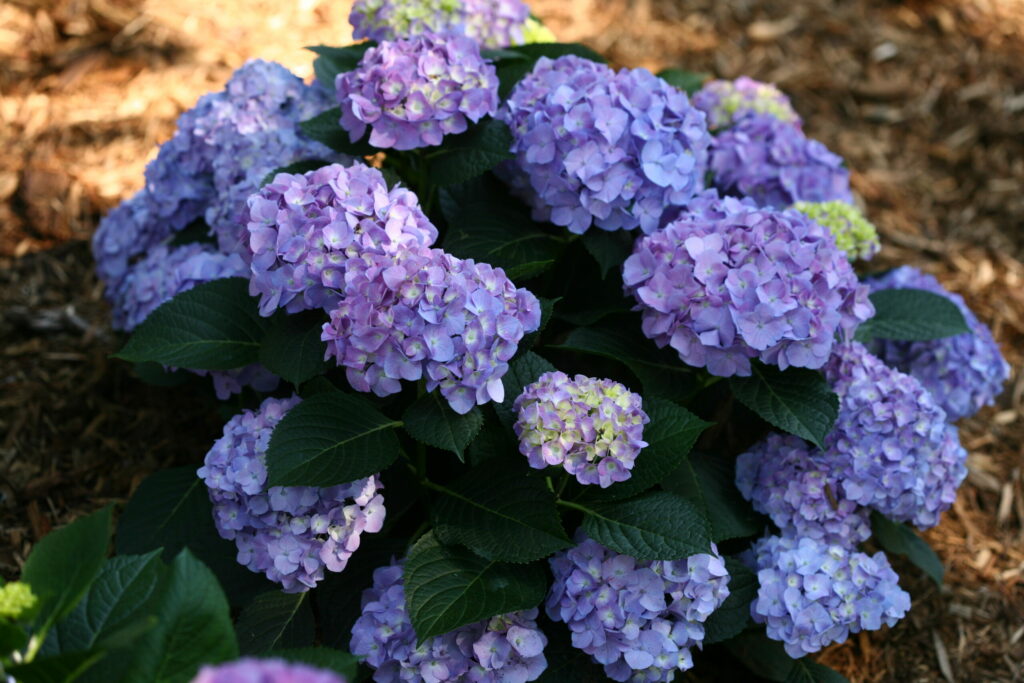If you want some big, showy flowers with bright, bold color, try planting some hydrangea. These classic choices are popular for many reasons, but beware the pink bloomer you have now could turn blue if your soil pH isn’t right.
There are two main types of hydrangeas. The Hydrangeas Macrophylla which is the type that can change color, and the Hydrangea Paniculata Grandiflora (PG hydrangea) this is shrub type. The Hydrangea Macrophylla has big, luscious flowers, and leaves, while the PG Hydrangea is a hardy type that will keep its blossoms through the fall and sometimes into the start of winter.
Hydrangea Macrophylla is a big leaf hydrangea. There are two types of big leaf hydrangeas. One has globe shaped flower heads, and the second is lace caps which have disc shaped flower heads. Hydrangeas can range in color from pale pink or pale blue, and include lilac, purple, violet or deep blue. Big leaf hydrangeas range in height from twelve to eighteen inches, to very large mounds, and are good companion plants for rhododendrons, azaleas and roses. There are several white varieties, and these do not change color.
The pH of your soil is what will determine the color of your Hydrangea. Hydrangeas change color based on the amount of aluminum they can take up. As pH decreases the amount of aluminum in the soil becomes more available and a hydrangea can absorb more of it. A pH between 5 ½ and 6 ½, acid soil, turns hydrangeas blue. If the pH is above 7 you will get pink flowers. To raise the pH you would add lime in some form, to lower the pH you could use aluminum sulfate.
Changing the color can be a somewhat tricky business. Many factors affect this process, but the results are quite obvious. I saw one hydrangea that had one part of the flower a brilliant pink, while the other half was mauve. This was caused by uneven absorption of the aluminum sulfate.
The Hydrangea Macrophilla blooms in mid summer and should be pruned after flowering. This hydrangea is not hardy, so plant where it will be protected or cover with burlap in winter. It comes in blue, pink or white.
The P.G. Hydrangea – H. Paniculata ‘grandiflora’ has blossoms that are white and gradually turn to pink or purple. The flowers last long into the season and can be trained to resemble a tree and probably are the most common in older yards. This hydrangea is a shrub and is hardy in our area. Pruning will increase the size of this hydrangea by encouraging more growth.
Some other common hydrangeas:
Oak Leaf Hydrangeas- H. Guercifolia- Just like the oak leaf which this hydrangea’s leaf resembles, this great foliage turns a wonderful red in the fall. Oak leaf flowers come in 6 “ cone shaped” clusters. These plants tend to spread, and can get quite large. Oak Leaf Hydrangeas should be pruned after they have flowered. It is in the fall and winter that they set the flower for the next season.
Hill of Snow Hydrangeas- H. Arborescens – This popular hydrangea has soft, green leaves and very large heads. Two common varieties are Annabelle and Grandiflora. These very showy hydrangeas can produce heads a foot wide. They bloom in mid summer, and are the only hydrangea that needs a different type of pruning. These varieties can withstand a hard pruning in early spring before any new growth begins.
Hydrangeas grow best in partially shaded, well-drained areas. If you do put them in the sun, choose a location that does not get full afternoon sun. In addition to creating a splash in the garden, Hydrangea are also great for dried flower arrangements. Wait until the flowers have aged to a papery texture, pick the leaves off the stems and hang them upside down in a dark, warm space. Keep the finished arrangement out of direct sunlight or the color will fade.
It can be a slow process getting a hydrangea to turn color, but if the hydrangea on the right side of the porch doesn’t match the one on the left side of the porch, it may be worth it to adjust the pH of one or the other and once again have a matched set.
